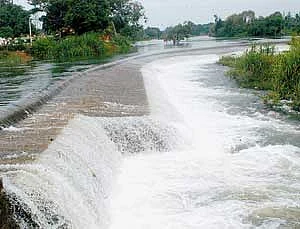

One cannot think of a travel itinerary for Karnataka, without a visit to Mysore, the state’s cultural capital. While a visit to the ancient city can by itself be a tour that encompasses several historic sights, one cannot discount the route to Mysore, for it is steadily punctuated with beautiful landscapes and historic landmarks that can transport us into the magic of another era.
When one travels to Mysore via Bangalore, one passes Srirangapatna, a stopover for people who want to witness the gracious coexistence of Hindu and Islamic culture. When you get there, you will make your trip worthwhile if you travel two kilometres to Ganjam. Local buses, cars, auto rickshaws and even horse drawn carts can take you there for a throwaway price if you do not have your own transport.
Ganjam’s vegetable market
When you weave your way through the busy makeshift market place that sells items of worship, the freshest fruits and vegetables at unbelievably low prices, you will find yourself at the doors of the temple premises which is the hallmark of Ganjam. Ganjam lies at the confluence of two rivers Lokapavani and Cauvery known as Sangam. This ancient town that was formed half a millennium ago was the land of the erstwhile kings of Mysore who built a beautiful temple for goddess Nimishamba at the Sangam.
The temple is cradled in the midst of a beautiful landscape. The Karighatta hills (black hills) that appear as silhouettes in the horizon border the waters of the confluence on one side while the other side is hemmed in intermittently by rushes, tropical trees and the temple stairs that lead to the waters.
You can spend your time by the riverside taking in the surreal beauty of the countryside and enjoy a picnic while at it. If you know swimming, the waters in this region will prove to be perfect for it is neither too deep nor are the currents rapid. If you are the enterprising sort, you can rent coracles for a fee of Rs ten or twenty, depending on how long you want to use the same and row down the calm waters and explore the other bank of the river. The men who row these coracles, some of whom know English and Hindi besides Kannada, can reel off the names of trees, plants and a dozen water birds that inhabit the place apart from telling you about the Sthala Purana or the local legend if you care to listen to them.
Diamond jewellers and more...
Though many Indians associate Ganjam with its famous diamond jewellers, the place is also known for its Nimishamba temple. The deity is believed to be the manifestation of goddess Parvathi who descended on earth to help sage Mukthaka to complete his Yagna. Local myth has it that people, who came to the goddess with faith, redeemed their wishes within a minute. They started referring to her as Nimishamba, the mother who fulfills wishes in a minute. By the mid-sixteenth century, a temple was built for the deity and was renovated again by Mummadi Krishnaraja Wodeyar, king of Mysore.
People throng this temple throughout the day. The temple is visited by at least one lakh devotees during Navarathri and the Vasavamba Jayanthi which is also known as Nimishamba Jayanthi, a festival to commemorate the descent of the goddess from the heavens.
If you happen to be a local tourist to Ganjam who hopes to return home at the end of the day, do not miss out on buying vegetables and fruits that are sold just outside the temple.
It is amazing to note that the place has not lost its pristine beauty despite the floating population that runs into thousands. The local people ensure that the place is clean as they look upon it as divine.
